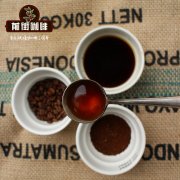Which is the first coffee producing area in Brazil? which is the first coffee producing area in the world?

Professional coffee knowledge exchange more coffee bean information please follow the coffee workshop (Wechat official account cafe_style)
Qianjie-introduction of coffee producing areas in Brazil
Brazil is the world's largest coffee producer, with the first total output in the world, accounting for about 1 of the world's total output. Brazil is mainly produced in the central and southern provinces. Brazil is suitable for growing coffee, the terrain is relatively flat, coffee gardens are mostly less than 1200 meters above sea level, and there is no shade from big trees, because raw and ripe berries are picked at the same time, so it is not fine coffee.
The quality of Brazilian coffee is average but less excellent, its bean quality is soft, and it is obviously not resistant to heat in the roasting process. Santos is more famous among all varieties, which is named after its export port Santos. Brazilian coffee beans are neutral and can be tasted alone (though a bit monotonous), or mixed with other kinds of coffee beans to form a comprehensive coffee, which is generally considered to be indispensable in blending.
Flavor characteristics: good Brazilian beans come from the old coffee tree of Bourbon clock, which smells obviously bitter and sweet, while some people use the term "extremely warm and smooth" to describe top Brazilian coffee. Brazil beans have always been an indispensable ingredient in espresso recipes because they are rich in oil. Good Brazilian beans have thickness, texture and sweetness, but they do not take away the flavor, providing the best stage for other coffee to enjoy.
Brazil is vividly compared to the "giant" and "monarch" of the coffee world. There are about 3.97 billion coffee trees there, and small farmers now grow 75% of the country's coffee. Brazil produces twice or even three times as many coffee as Colombia, which is the world's second-largest coffee producer (previously, Vietnam is now the second-largest coffee producer).
As there are so many kinds of Brazilian coffee in Brazil, you can't just use the word "Brazilian coffee" to include it. Like other Arabica coffee, Brazilian coffee is called "Brazils" to distinguish it from "Milds" coffee. The vast majority of Brazilian coffee is unwashed and sun-dried and is classified according to the name of the state of origin and port of transport. Brazil has 21 states and 17 states produce coffee, but four of them produce the largest, accounting for 98 per cent of national production: Parana, Sao Paulo, Minas Gerais and Espirito Santo, with the southern state producing the most, accounting for 50 per cent of total production.
Although coffee is diverse, Brazilian coffee is suitable for the taste of the public. For example, coffee produced in the northern coastal areas has a typical iodine taste, reminiscent of the sea after drinking. This coffee is exported to North America, the Middle East and Eastern Europe.
Another kind of coffee that is interesting and worth looking for is washed Bahia coffee. This kind of coffee is not easy to find because Brazil is the world's largest consumer of coffee after the United States, and many of the best coffee can only be found in its domestic market.
Knowledge: since the opening of the free market since 1990, the original Brazilian Coffee Authority (IBC) has been replaced by the National Economic Association, the country's non-investment administrative body, which pursues a policy of non-intervention and allows producers to negotiate directly with exporters.
In short: Qianjie is a coffee research hall, happy to share the knowledge about coffee with you, we share unreservedly just to make more friends fall in love with coffee, and there will be three low-discount coffee activities every month. The reason is that Qianjie wants to make more friends drink the best coffee at the lowest price, which has been Qianjie's tenet for 6 years!
END
Important Notice :
前街咖啡 FrontStreet Coffee has moved to new addredd:
FrontStreet Coffee Address: 315,Donghua East Road,GuangZhou
Tel:020 38364473
- Prev

The producing area of boutique coffee beans, the best coffee in Ethiopia in Africa, has to mention this wetland.
Professional coffee knowledge exchange more coffee bean information please follow the coffee workshop (Wechat official account cafe_style) Qianjie-Yega Xuefei producing area introduces the general impression of Africa, they have higher temperature and less moisture. So for beans on the African side, most of them are treated in the sun. The sun exposure method because it is directly exposed to the sun in the open area.
- Next

How does Yunnan small grain coffee taste? Yunnan small grain coffee taste characteristics rich and mellow aroma
Professional coffee knowledge exchange more coffee bean information please follow the coffee workshop (Wechat official account cafe_style) front street-Yunnan small grain coffee introduction Zhukula coffee forest belongs to Arabica bean (Arabica) Yunnan small grain Bobang (bourbon) and Typica varieties. At present, the Arabica coffee garden planted in Yunnan has more than 300,000 mu. Small grains of coffee are suitable for raw.
Related
- Beginners will see the "Coffee pull flower" guide!
- What is the difference between ice blog purified milk and ordinary milk coffee?
- Why is the Philippines the largest producer of crops in Liberia?
- For coffee extraction, should the fine powder be retained?
- How does extracted espresso fill pressed powder? How much strength does it take to press the powder?
- How to make jasmine cold extract coffee? Is the jasmine + latte good?
- Will this little toy really make the coffee taste better? How does Lily Drip affect coffee extraction?
- Will the action of slapping the filter cup also affect coffee extraction?
- What's the difference between powder-to-water ratio and powder-to-liquid ratio?
- What is the Ethiopian local species? What does it have to do with Heirloom native species?

